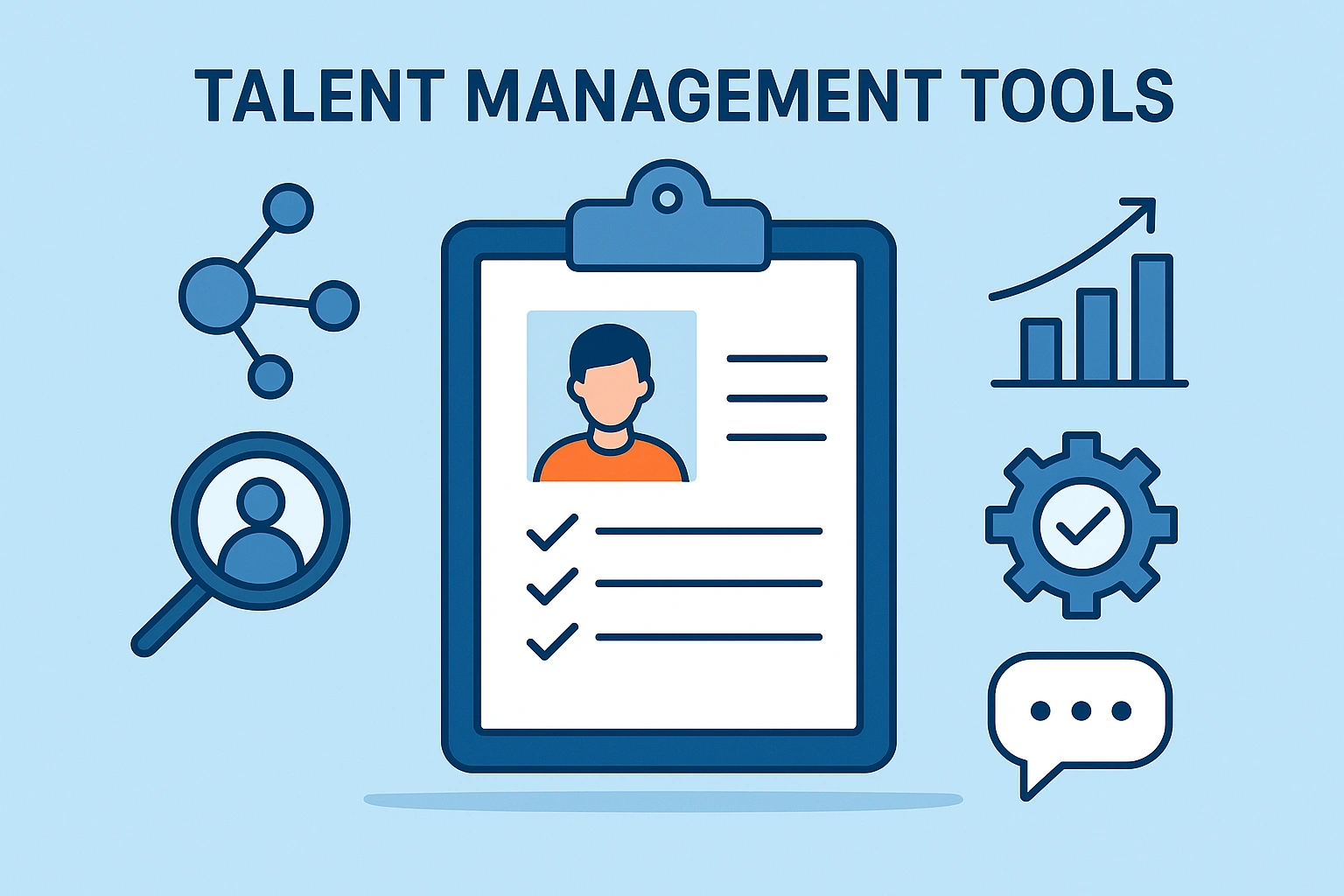With businesses now competing at a fast pace, managing their talent properly is crucial for organizations to attract, keep, and grow the best workers. All the top 10 talent management tools on our list are chosen based on how well they perform, what features they provide, what reviews say, their ability to scale up, how innovative they are, and how much they are praised in the industry. They provide a wide range of services for hiring, starting new employees, checking their progress, keeping staff involved, and developing their skills.
HR professionals, team leaders, and department heads from many industries count on them to serve developers, designers, marketers, customer service teams, and similar teams. These tools use automation, analytics, and AI to simplify HR duties, link employee aims with company goals, and increase employee productivity. Both startups looking to add staff and global enterprises working with a remote workforce can use these tools to fit unique requirements. They are important for companies because they deliver the tools to create flexible and successful teams in a competitive world where talent is in demand.
Criteria to Select the Best Talent Management Tools
Following points will exhibit the main criteria for choosing the top talent management tools in 2025:
- Feature set and functionality: The tool must support various activities, for instance, recruitment, starting a job, performance reviews, staff training and succession planning.
- User experience and interface: Smart and simple navigation makes sure that all those who use the HR system can do so easily and quickly.
- Integration capabilities: The system needs to be able to connect with payroll, HRIS, and collaboration solutions so processes are straightforward.
- Scalability and flexibility: The platform ought to serve the needs of companies regardless of size or the industries they work in and it must cover global or remotely located employees.
- Both AI and automation: Today’s HR technology should rely on AI and automation to guide better choices, reduce routine tasks for staff, and improve employees’ work-life.
- Customer service: Good customer assistance, starting resources, and learning opportunities help ensure you can keep working with the tool well.
- Evaluations and reputation: Tools were chosen using user feedback, scores, and recognition from trustworthy market analysts and authorities.
- Security and compliance: Sticking to worldwide rules (such as GDPR) and using secure systems is important to keep employee data safe.
Top 10 Talent Management Tools
1. ChartHop
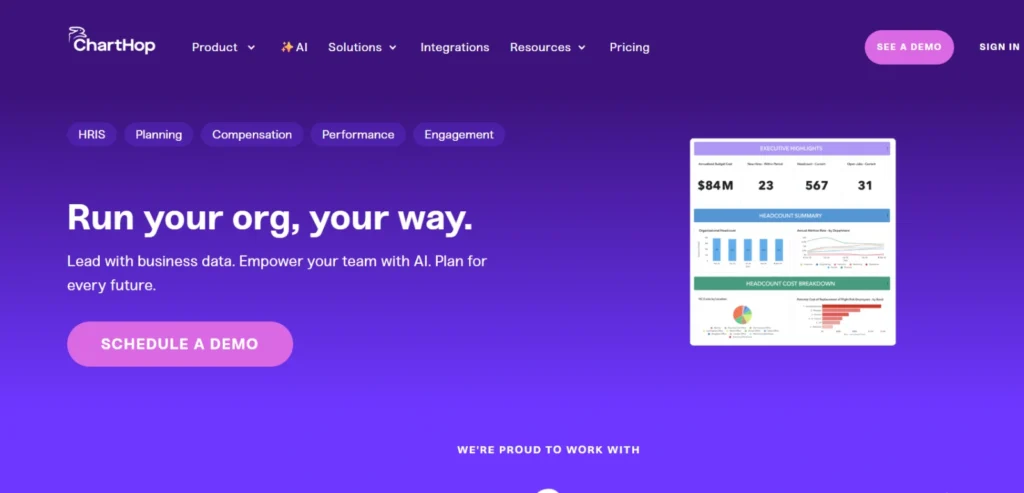
ChartHop is a new talent management tool that organizes people’s data to make the insights useful. Among its main highlights are live org charts, headcount planning, reviews of compensation, and diversity reporting. Thanks to its compatibility with most HR platforms, ChartHop offers current analytics to help with workforce planning. Thanks to the platform, HR leaders can view their teams’ setups, observe their progress, and keep team efforts aligned with organizational aims.
Increased visibility and ease of data access give companies the chance to make quicker, smarter talent choices which also encourages better teamwork between HR, finance, and leadership, which is why Talent Management Tools are essential for success.
Key Features:
- Dynamic org chart with real-time updates
- Compensation planning and scenario modeling
- DEI (Diversity, Equity, Inclusion) analytics
- Headcount and workforce planning
- Integration with major HRIS platforms
Pros:
- Highly visual and intuitive interface
- Excellent for strategic planning and data-driven decisions
Cons:
- May be overwhelming for small teams
- Advanced features require higher-tier pricing
Pricing:
$8/employee/month for the first module.
Who Should Use It?
Ideal for mid-sized to large organizations needing real-time visibility and analytics for workforce planning.
2. Workday
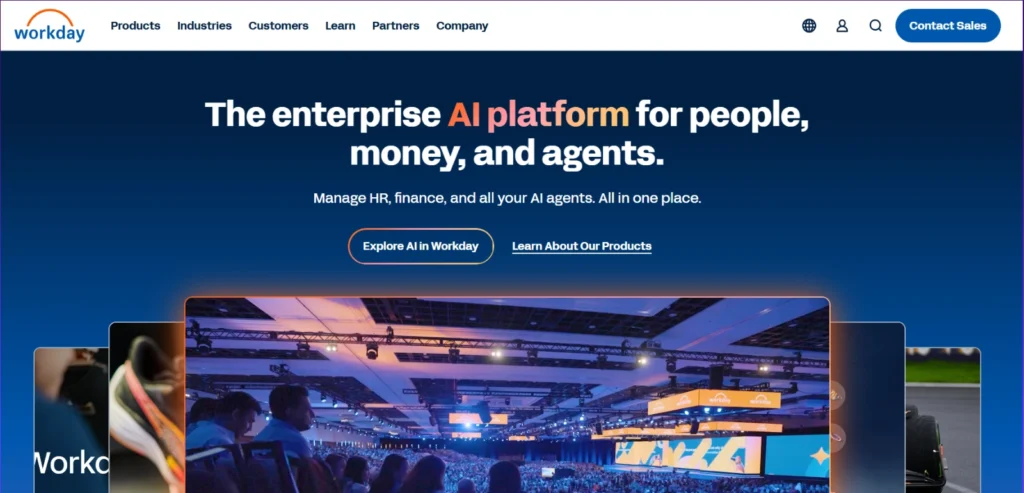
Workday is a major HCM platform that provides artificial intelligence in HR, finance, and planning. It simplifies important HR functions such as recruiting, starting onboarding, doing payroll, managing performance, and analyzing staff members. The simple setup, enhanced by machine learning, allows users to decide more quickly based on data. Workday’s ability to connect smoothly and expand makes it perfect for big organizations.
Organizations stay flexible by making use of talent optimization, gathering insights at the moment, and planning flexibly. Because Workday keeps improving and values user experience, it is a top choice for businesses wanting to streamline HR activities with effective Talent Management Tools.
Key Features:
- AI-powered talent acquisition and management
- Workforce and skills analytics
- Continuous performance tracking
- Global payroll and time tracking
- Mobile accessibility and user-friendly interface
Pros:
- Deep integration across HR and financial operations
- Scalable for large enterprises
Cons:
- High learning curve for new users
- Expensive for small businesses
Pricing:
Custom enterprise pricing; free quote available upon request.
Who Should Use It?
Best suited for large enterprises seeking an all-in-one HCM platform with robust analytics and automation.
3. SAP SuccessFactors
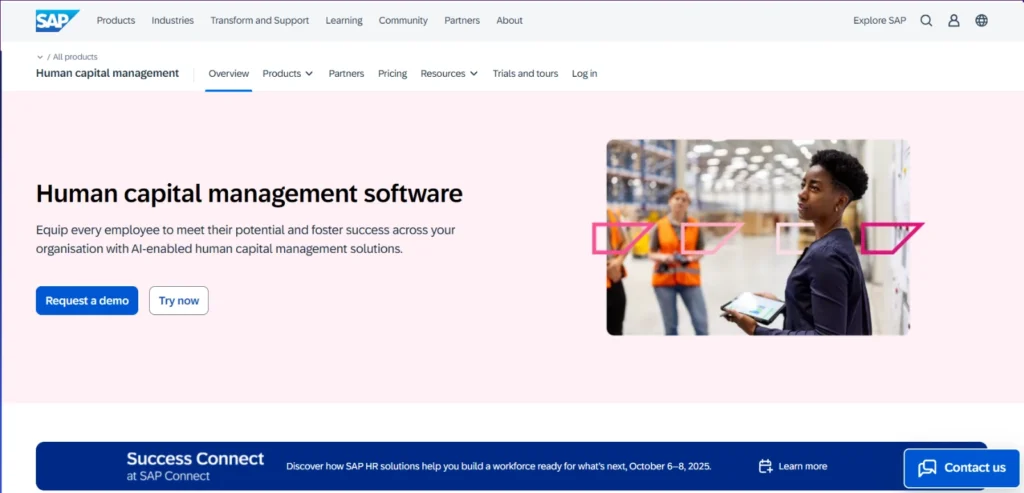
SAP SuccessFactors helps businesses by connecting employee achievement with their goals. The platform helps with all aspects of talent management such as recruiting, onboarding, learning, managing performance, and planning for future talent leadership. The platform’s power comes from its ability to operate globally, adjust to any scale, and analyze data well. It helps businesses support their employees by giving them personalized learning and frequent feedback. Their systems work well together and help organizations comply with regulations everywhere.
The main goals of engagement and alignment are what makes the platform ideal for organizations aiming to improve their working environment through advanced Talent Management Tools.
Key Features:
- Goal and performance management
- Learning and development (LMS)
- Succession and career planning
- Core HR and payroll integration
- Employee central and workforce analytics
Pros:
- Strong global HR capabilities
- Integrates well with SAP’s enterprise ecosystem
Cons:
- Can be complex to implement
- Premium pricing for full feature access
Pricing:
Modular pricing; typically starts around $17/month depending on selected modules.
Who Should Use It?
Best for global companies and SAP-centric organizations needing comprehensive workforce solutions.
4. Deel
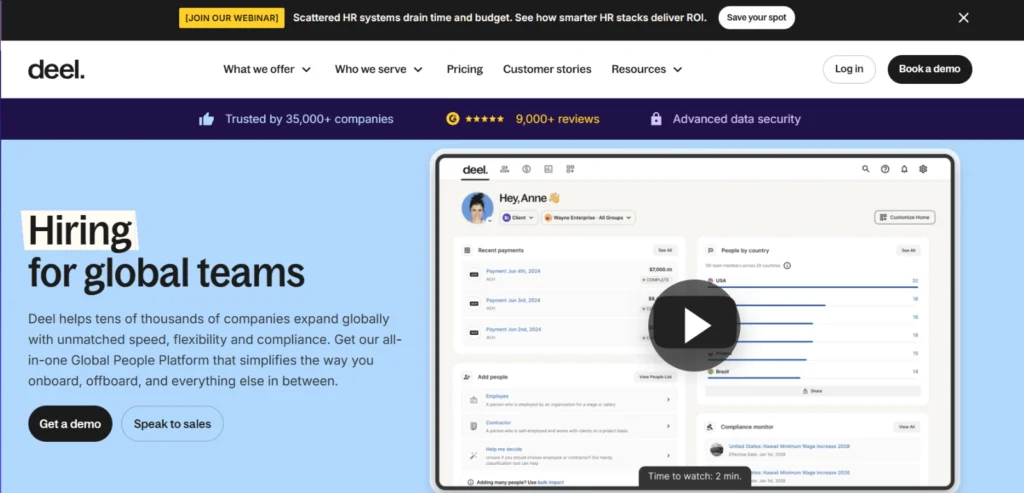
Deel supports international and remote teams by handling their HR and payroll. With such a service, companies can hire, onboard, and oversee every type of employee in over 150 countries, making sure they are compliant with all the local laws. Everything from contract development, managing taxes, and processing salary payments, to handling employee benefits can be done by Deel. The clear platform makes it easier for companies worldwide to manage legal issues and doesn’t add to their already busy schedules.
Deel provides strong support and connects with common HR platforms, which is why startups and other businesses with remote staff pick it for their growth as one of the best Talent Management Tools.
Key Features:
- Global payroll and contractor payments
- International tax and legal compliance
- Remote onboarding tools
- Employee benefits administration
- Integrations with major HRIS systems
Pros:
- Excellent for managing global remote teams
- Simplifies complex legal compliance
Cons:
- Limited local HR functionality outside payroll/compliance
- Higher costs for smaller startups
Pricing:
Starts at $49/month per contractor; custom pricing for EOR services.
Who Should Use It?
Ideal for companies hiring internationally or managing distributed workforces.
5. Keka
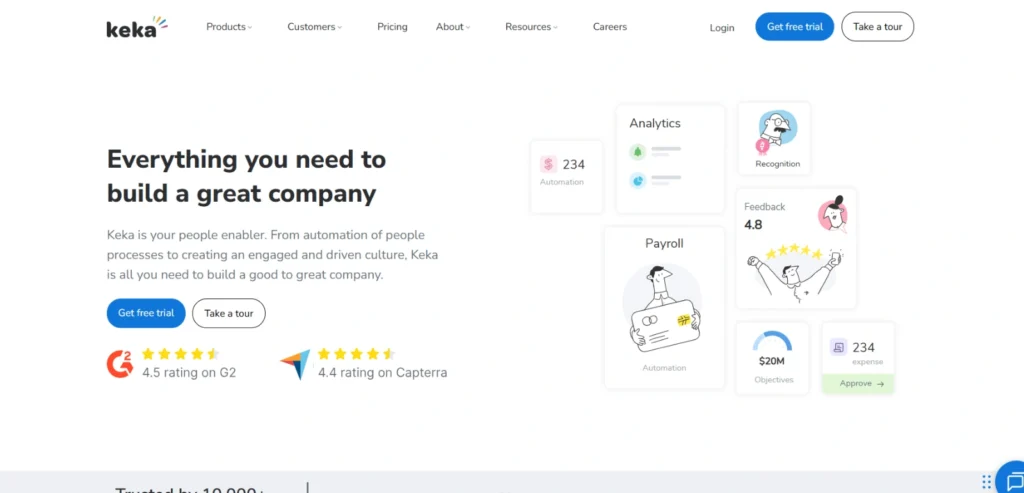
Keka is a platform designed for small and medium-sized firms that puts people at its heart. It includes tools that are straightforward and deal with attendance, conducting appraisals, setting goals, and keeping employees engaged. With Keka, continuous feedback, open tracking of performance, and easy review routines are made possible. The system helps organizations personalize their processes and goals based on their own culture. Employee details, time tracking, all payroll matters, and leave and expense records are handled within the platform.
Centered on automation and making things easy, among all the best talent management tools, Keka gives businesses a chance to simplify HR and encourage employee growth.
Key Features:
- Performance appraisal and feedback
- Payroll and compliance automation
- Timesheet and attendance tracking
- Goal and OKR management
- Employee self-service portal
Pros:
- Budget-friendly and user-friendly
- Great for small to mid-sized businesses
Cons:
- Limited international compliance features
- Basic analytics compared to top-tier competitors
Pricing:
Starts at ₹9,999/month upto 100 employees; varies by module and company size.
Who Should Use It?
Best for SMBs in India and emerging markets looking for affordable HR automation.
6. ClearCompany
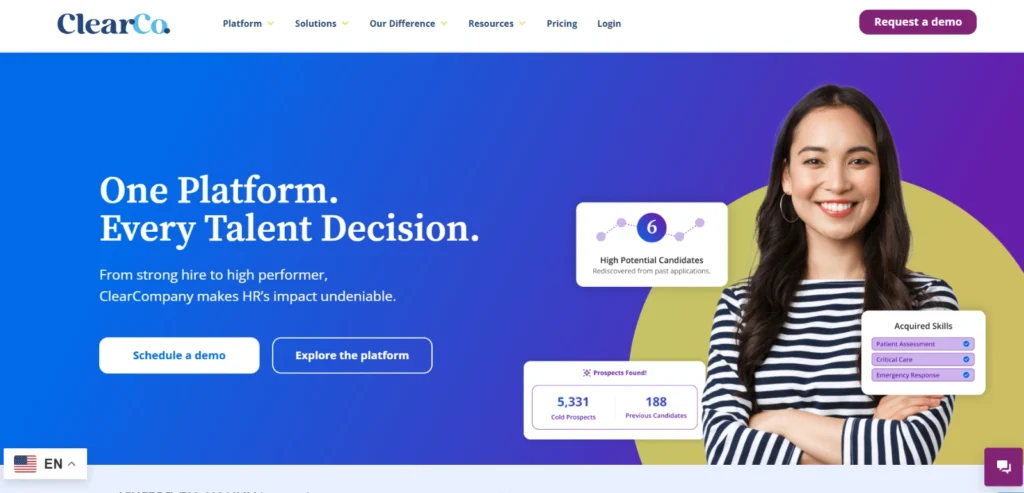
ClearCompany is recognized for helping companies manage their talent and link this process to their overall aims. This means applicant tracking, handling onboarding, managing performance reviews, and setting goals are available. ClearCompany helps businesses connect what employees want to achieve with the overall goals of the company. Because performance is clear for everyone and goals are shared, HR teams can recognize and update top employees without difficulty. Using analytics, companies can make better choices about their workforce.
If you lead a mid-sized company, ClearCompany offers a single system to handle your employees from start to finish. It is widely recognized for its effective Talent Management Tools.
Key Features:
- Applicant tracking system (ATS)
- Onboarding workflows
- Goal alignment and tracking
- Performance reviews and feedback
- Talent analytics and reporting
Pros:
- Strong recruitment and onboarding tools
- Easy goal alignment with company objectives
Cons:
- Limited advanced analytics features
- Less suited for global enterprises
Pricing:
Custom pricing; typically mid-range for SMBs.
Who Should Use It?
Ideal for growing businesses focused on aligning recruitment and performance with strategic goals.
7. Lattice
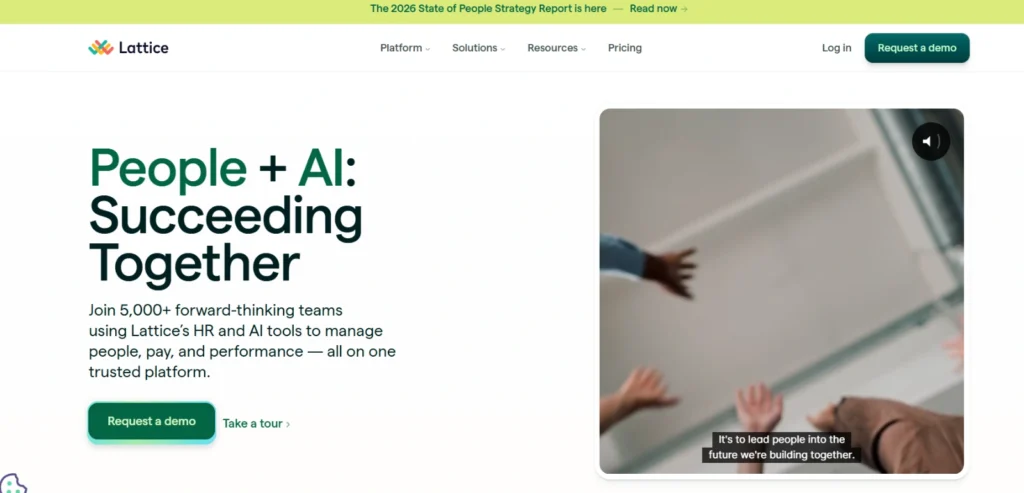
The purpose of Lattice is to guide team growth by creating a helpful feedback culture. It provides users with goal setting (OKRs), meeting templates, ways to give suggestions, and the possibility to review performance. With Lattice, employees and managers can make sure they are both working towards the same goals. With analytics, you can see how engaged employees are, and how productive they are and understand their moods. Lattice can be used by recent organizations centered on supporting individual growth, as it connects easily with widely used HRIS systems.
As continuous performance management makes workforces retain information, feel happier, and grow, it is loved by some of the more innovative HR groups for its reliable Talent Management Tools.
Key Features:
- Continuous performance management
- Goal setting and OKRs
- Engagement surveys and analytics
- 1:1 meeting and feedback tools
- Career development planning
Pros:
- Intuitive UI focused on employee experience
- Encourages regular feedback and growth
Cons:
- Limited recruitment features
- Pricing may not suit small teams
Pricing:
Starts at $11/user/month for performance management; higher tiers for additional modules.
Who Should Use It?
Great for companies prioritizing performance culture and employee engagement.
8. TalentSoft
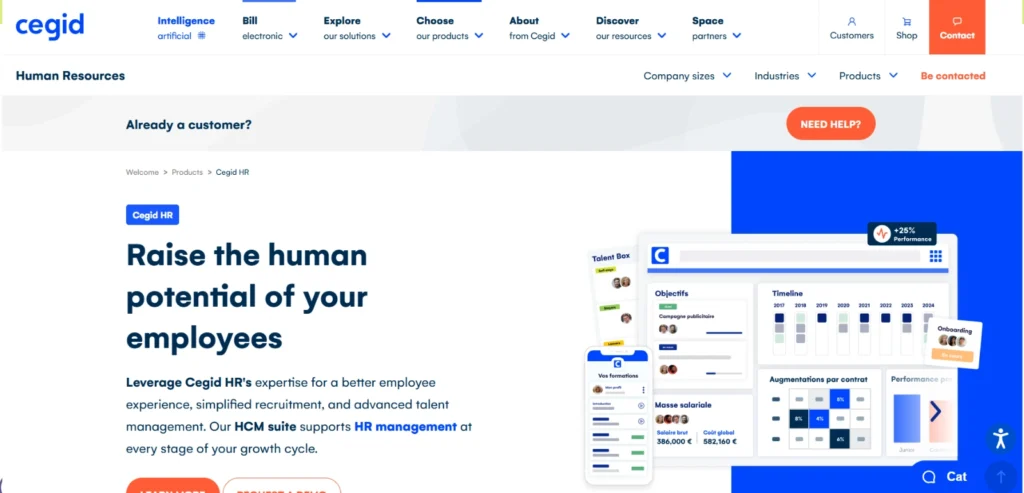
TalentSoft is headquartered in Europe as a way to help people and companies boost employee growth. It gives you everything needed for evaluating staff, guiding careers, managing learning, and planning compensation. Personalized learning and the ability to use multiple languages mean TalentSoft suits international organizations best. The platform makes use of AI to show workers personalized advice and opportunities for moving within the organization. Because of its collaborative nature, managers and employees are able to develop growth plans that fit the company’s needs.
Talent Management Tools like TalentSoft are useful for businesses that are most concerned with helping their teams grow and improve through smart and flexible HR management.
Key Features:
- Learning and development tools
- Succession and talent review planning
- Compensation and performance management
- Employee surveys and feedback
- Multi-language and global compliance
Pros:
- Strong learning management capabilities
- Suitable for European companies
Cons:
- Less popular in North America
- UX can feel dated compared to newer tools
Pricing:
Custom pricing; enterprise-focused.
Who Should Use It?
Ideal for mid-to-large European companies focused on L&D and succession planning.
9. Oracle Cloud HCM
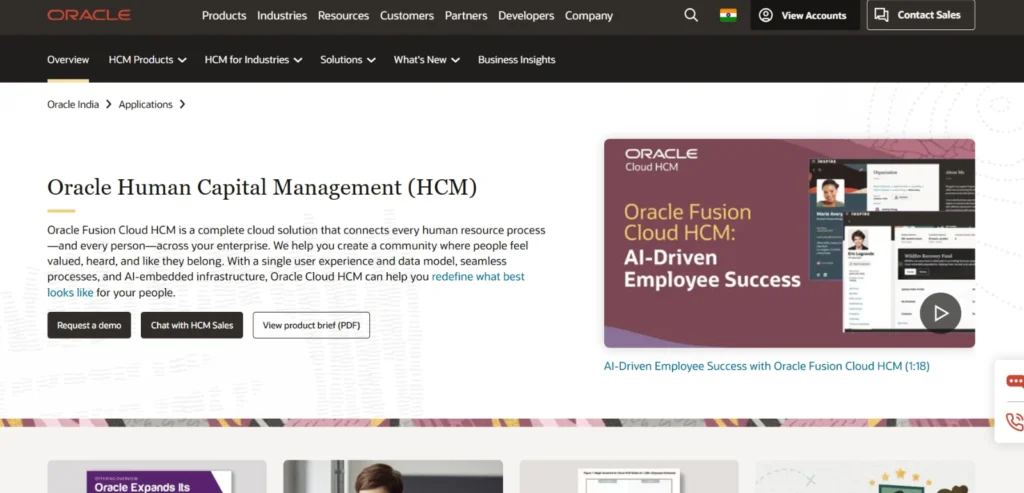
As a full-suite HCM solution, Oracle Cloud HCM gives users access to tools for worldwide HR, management of the workforce, and employee growth. With AI, GetRecruit supports recruitment, bringing on employees, managing their performance, and keeping them motivated. Because Oracle works well with several enterprise tools, it helps every department access data insights. Advanced analytics, modeling the workforce, and providing tailored employee experiences are all part of HCM. The strong scalability, good security, and flexibility of Oracle Cloud HCM make it fit for large enterprise organizations.
Talent Management Tools that highlight innovation, automation, and a single employee record help companies efficiently organize operations and support suitable hiring plans.
Key Features:
- Global HR and talent acquisition
- Workforce planning and optimization
- Advanced AI-driven analytics
- Payroll and benefits administration
- Mobile-friendly employee experience
Pros:
- Comprehensive enterprise-grade suite
- Scalable and highly customizable
Cons:
- High implementation complexity
- Premium pricing model
Pricing:
Custom pricing; enterprise-tier.
Who Should Use It?
Best for large, multinational enterprises needing a robust, end-to-end HCM platform.
10. iCIMS
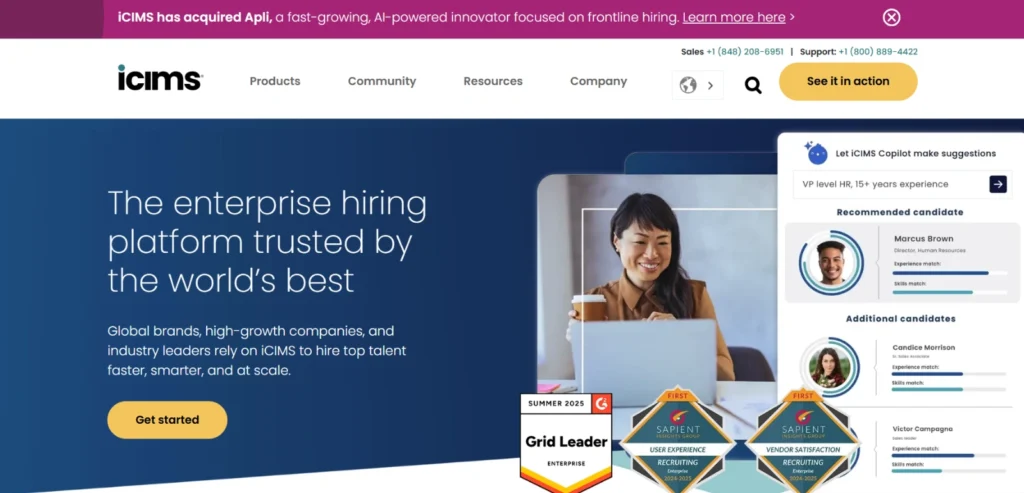
iCIMS is a top platform built for finding talent, featuring many helpful tools for the whole hiring period. The Talent Cloud from iCIMS includes applicant tracking, candidate management, website design, offer management, and onboarding. It supports companies in recruiting the best candidates with unique experiences and automated communication.
Talent Management Tools like iCIMS strengthen recruitment results and reputation among potential employees thanks to their easy connection with other HR programs and extensive data. This process works most for companies that value speed in hiring, a good experience for candidates, and using data.
Key Features:
- Applicant Tracking System (ATS)
- Career site builder and CRM
- Offer and onboarding management
- Video interviewing and assessments
- Analytics and recruitment marketing
Pros:
- Strong specialization in recruitment workflows
- Highly configurable and scalable
Cons:
- Limited features outside talent acquisition
- Integration with other HR tools may be needed
Pricing:
Custom pricing based on company size and features.
Who Should Use It?
Ideal for companies with complex recruiting needs or high-volume hiring.
Comparison Between Different Talent Management Tools
| Tool | Key Features | Pricing | Use Cases | Website |
| ChartHop | Live org chart, DEI analytics, headcount planning, compensation reviews, HRIS integration | $8/employee/month for the first module | Mid to large organizations needing real-time workforce visibility and analytics | charthop.com |
| Workday | AI-powered talent acquisition, global payroll, performance tracking, workforce analytics, mobile support | Custom enterprise pricing | Large enterprises seeking an all-in-one HCM platform with robust analytics and automation | workday.com |
| SAP SuccessFactors | Goal and performance management, LMS, succession planning, core HR, workforce analytics | starts at $17/month | Global companies and SAP-centric organizations needing comprehensive workforce solutions | sap.com |
| Deel | Global payroll, remote onboarding, tax/legal compliance, benefits administration, HRIS integration | Starts at $49/month per contractor; custom pricing for EOR services | Companies hiring internationally or managing distributed workforces | deel.com |
| Keka | Performance appraisal, payroll automation, timesheet tracking, goal setting, employee self-service portal | Starts at ₹9,999/month upto 100 employees; varies by module and company size | Small to medium-sized businesses in India seeking affordable HR automation | keka.com |
| ClearCompany | Applicant tracking system, onboarding workflows, goal alignment, performance reviews, talent analytics | Custom pricing; typically mid-range for SMBs | Growing businesses focused on aligning recruitment and performance with strategic goals | clearcompany.com |
| Lattice | Continuous performance management, goal setting (OKRs), engagement surveys, 1:1 meetings, career development planning | Starts at $11/user/month for performance management; higher tiers for additional modules | Companies prioritizing performance culture and employee engagement | lattice.com |
| TalentSoft | Learning and development tools, succession planning, compensation management, employee surveys, multi-language support | Custom enterprise pricing | Mid to large European companies focused on learning and development and succession planning | cegid.com |
| Oracle Cloud HCM | Global HR, talent acquisition, workforce planning, AI-driven analytics, payroll, mobile-friendly experience | Custom enterprise pricing | Large, multinational enterprises needing a robust, end-to-end HCM platform | oracle.com |
| iCIMS | Applicant tracking system, career site builder, offer and onboarding management, video interviewing, recruitment analytics | Custom pricing based on company size and features | Companies with complex recruiting needs or high-volume hiring | icims.com |
Conclusion
To sum up, organizations in modern times can rely on 2025’s Talent Management Tools for their diversity of capabilities. Deel is notable for businesses with international teams because of its strict compliance and payroll offerings. Firms interested in a solution that combines AI with various HR functions should consider Workday or Oracle Cloud HCM. Businesses interested in supporting their employees through feedback, learning, and growth can choose between Lattice and TalentSoft. If you’re managing a startup or small business, Keka’s friendly and low-cost design could make HR tasks much easier.
Talent Management Tools like ChartHop are the go-to choice for data-driven workforce planning, whereas ClearCompany works better for people who focus on goal alignment and tracking their staff’s performance. If your organization is mainly concerned with recruitment, iCIMS makes it easy to track candidates and manage how they are contacted. Every tool offers features to support the goals of an organization, whether in expanding operations, bettering employee quality of life, or strategically advancing staff talent. Your decision about which platform to use will depend on the size of your team, its structure, desired goals, and how much customization you want.
FAQs
1. What do talent management tools involve and why should they matter to organizations?
Talent Management Tools are tools designed to help firms control the employee lifecycle, starting from recruitment through to performance and development. Their value shows when HR procedures are made easy, employees take pride in their work, and team goals line up with company objectives.
2. Who are the best candidates for using talent management software?
Talent Management Tools are particularly helpful for HR professionals, team managers, and business leaders of all kinds. Any business—startups, mid-level firms, or large organizations—can improve by being more efficient, using data, and helping workers enhance their skills.
3. What things should I consider when selecting a talent management tool?
Talent Management Tools have main features such as recruitment, introducing new staff, planning their goals, performance reviews, training and learning, planning future succession, and analyzing results. It is important that the system can work together with existing HR tools and doesn’t require a complex setup.
4. How do I find the right tool for managing my employees?
When choosing Talent Management Tools, check your organization’s size, the industry it operates in, its HR needs, and whether these are local or international. Don’t forget to review the user interface, available support, how the platform grows with your company, and user feedback.
5. Do the software solutions available for managing talent link with HR databases?
Most modern solutions can be integrated with HRIS, payroll, tracking applicants, and productivity software to make data sharing easier and HR tasks seamless.
